Compare and Contrast: Absolute and Relative Poverty in Economics
VerifiedAdded on 2023/06/08
|6
|1538
|334
Essay
AI Summary
This essay provides a comparative analysis of absolute and relative poverty. Absolute poverty is defined as the lack of basic necessities like food, shelter, and clothing, often measured by a specific income threshold. Relative poverty, on the other hand, considers an individual's economic standing relative to others in their environment, focusing on living standards and societal norms. The essay contrasts the two concepts based on biological needs, income levels, and state dependency, highlighting how absolute poverty is more prevalent in developing countries and relative poverty in developed countries. It further discusses how government interventions and programs can affect absolute poverty, while relative poverty is influenced by income inequality and societal standards. The conclusion emphasizes the importance of addressing extreme poverty and promoting wealth distribution to reduce disparities and improve the quality of life for all.
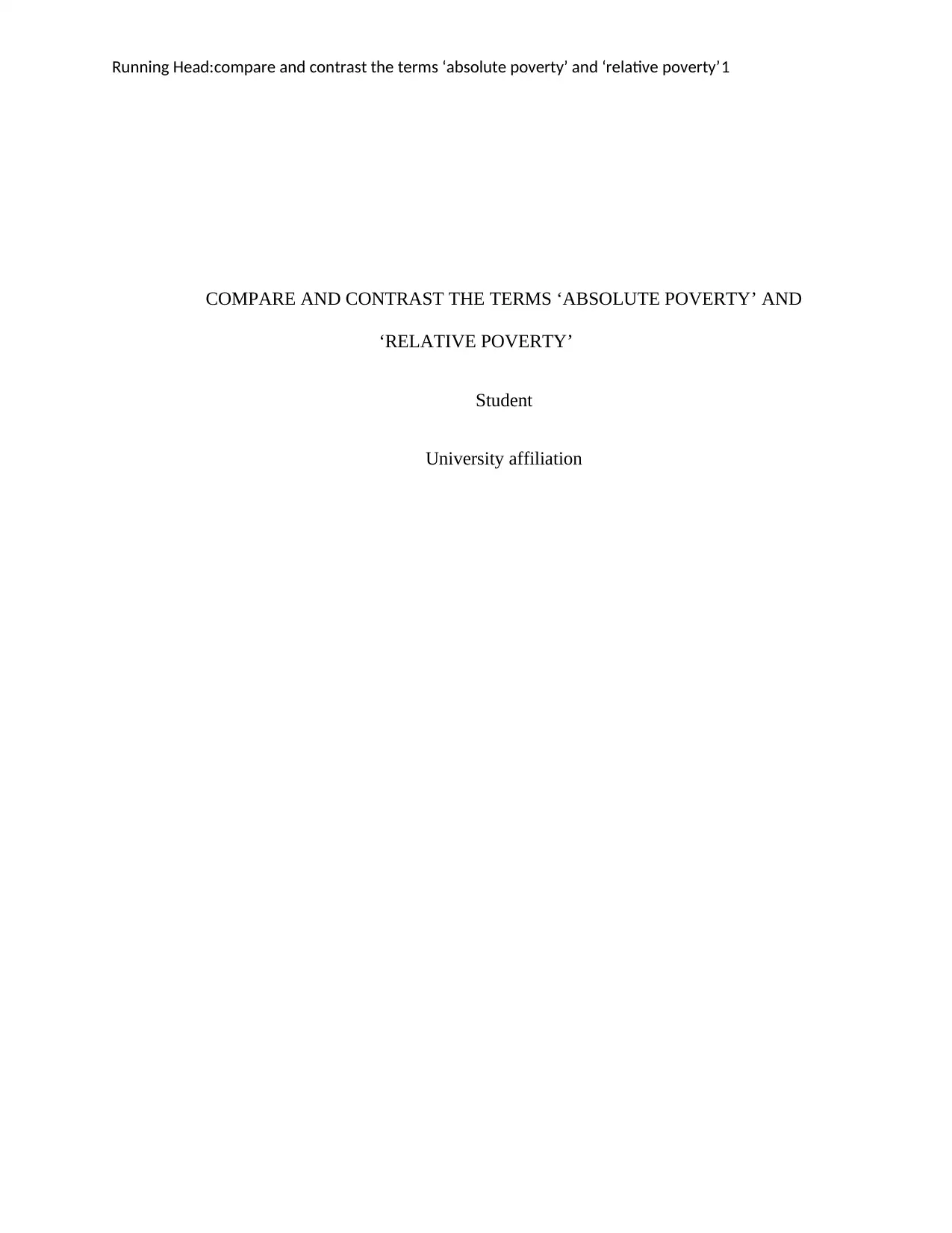
Running Head:compare and contrast the terms ‘absolute poverty’ and ‘relative poverty’1
COMPARE AND CONTRAST THE TERMS ‘ABSOLUTE POVERTY’ AND
‘RELATIVE POVERTY’
Student
University affiliation
COMPARE AND CONTRAST THE TERMS ‘ABSOLUTE POVERTY’ AND
‘RELATIVE POVERTY’
Student
University affiliation
Paraphrase This Document
Need a fresh take? Get an instant paraphrase of this document with our AI Paraphraser
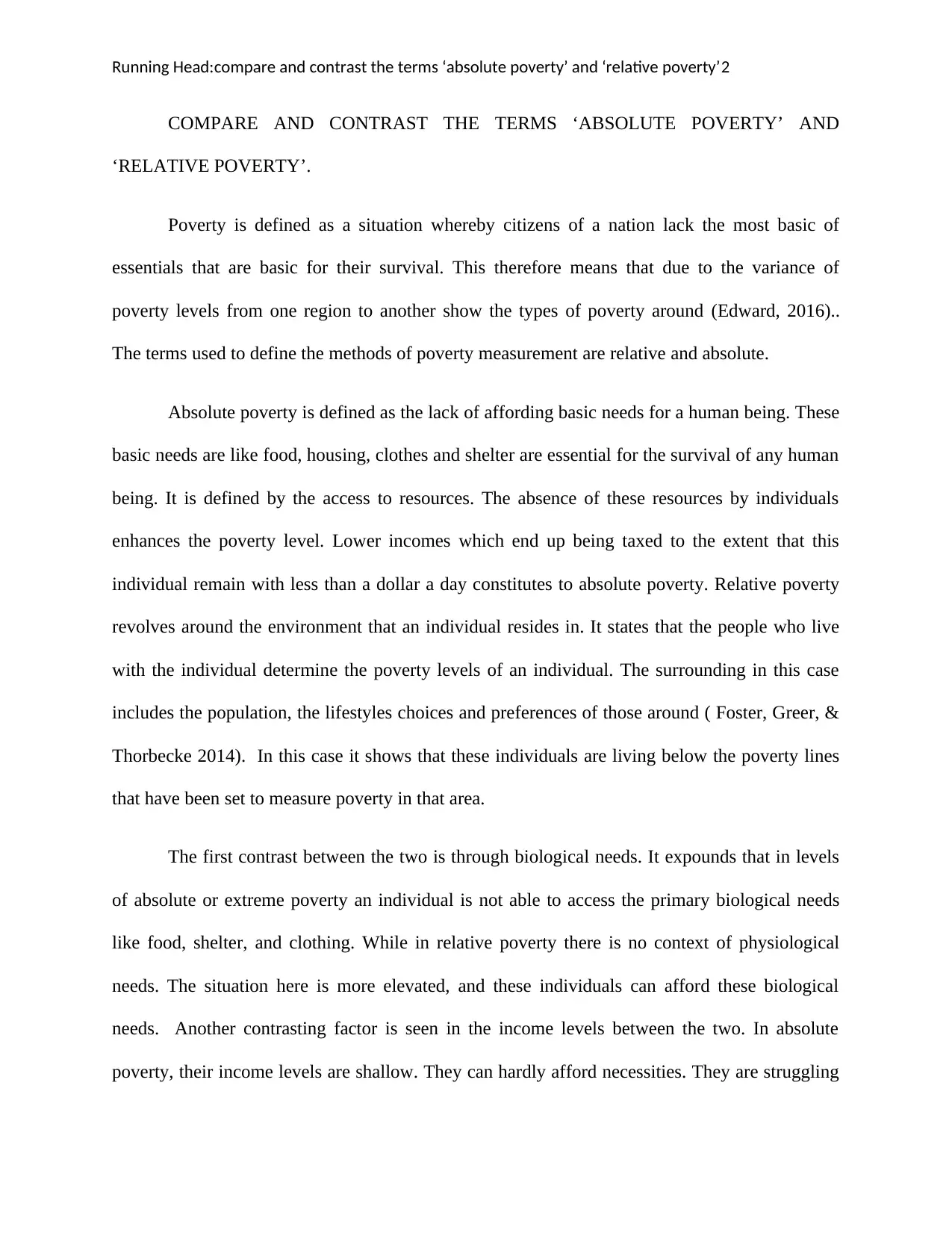
Running Head:compare and contrast the terms ‘absolute poverty’ and ‘relative poverty’2
COMPARE AND CONTRAST THE TERMS ‘ABSOLUTE POVERTY’ AND
‘RELATIVE POVERTY’.
Poverty is defined as a situation whereby citizens of a nation lack the most basic of
essentials that are basic for their survival. This therefore means that due to the variance of
poverty levels from one region to another show the types of poverty around (Edward, 2016)..
The terms used to define the methods of poverty measurement are relative and absolute.
Absolute poverty is defined as the lack of affording basic needs for a human being. These
basic needs are like food, housing, clothes and shelter are essential for the survival of any human
being. It is defined by the access to resources. The absence of these resources by individuals
enhances the poverty level. Lower incomes which end up being taxed to the extent that this
individual remain with less than a dollar a day constitutes to absolute poverty. Relative poverty
revolves around the environment that an individual resides in. It states that the people who live
with the individual determine the poverty levels of an individual. The surrounding in this case
includes the population, the lifestyles choices and preferences of those around ( Foster, Greer, &
Thorbecke 2014). In this case it shows that these individuals are living below the poverty lines
that have been set to measure poverty in that area.
The first contrast between the two is through biological needs. It expounds that in levels
of absolute or extreme poverty an individual is not able to access the primary biological needs
like food, shelter, and clothing. While in relative poverty there is no context of physiological
needs. The situation here is more elevated, and these individuals can afford these biological
needs. Another contrasting factor is seen in the income levels between the two. In absolute
poverty, their income levels are shallow. They can hardly afford necessities. They are struggling
COMPARE AND CONTRAST THE TERMS ‘ABSOLUTE POVERTY’ AND
‘RELATIVE POVERTY’.
Poverty is defined as a situation whereby citizens of a nation lack the most basic of
essentials that are basic for their survival. This therefore means that due to the variance of
poverty levels from one region to another show the types of poverty around (Edward, 2016)..
The terms used to define the methods of poverty measurement are relative and absolute.
Absolute poverty is defined as the lack of affording basic needs for a human being. These
basic needs are like food, housing, clothes and shelter are essential for the survival of any human
being. It is defined by the access to resources. The absence of these resources by individuals
enhances the poverty level. Lower incomes which end up being taxed to the extent that this
individual remain with less than a dollar a day constitutes to absolute poverty. Relative poverty
revolves around the environment that an individual resides in. It states that the people who live
with the individual determine the poverty levels of an individual. The surrounding in this case
includes the population, the lifestyles choices and preferences of those around ( Foster, Greer, &
Thorbecke 2014). In this case it shows that these individuals are living below the poverty lines
that have been set to measure poverty in that area.
The first contrast between the two is through biological needs. It expounds that in levels
of absolute or extreme poverty an individual is not able to access the primary biological needs
like food, shelter, and clothing. While in relative poverty there is no context of physiological
needs. The situation here is more elevated, and these individuals can afford these biological
needs. Another contrasting factor is seen in the income levels between the two. In absolute
poverty, their income levels are shallow. They can hardly afford necessities. They are struggling
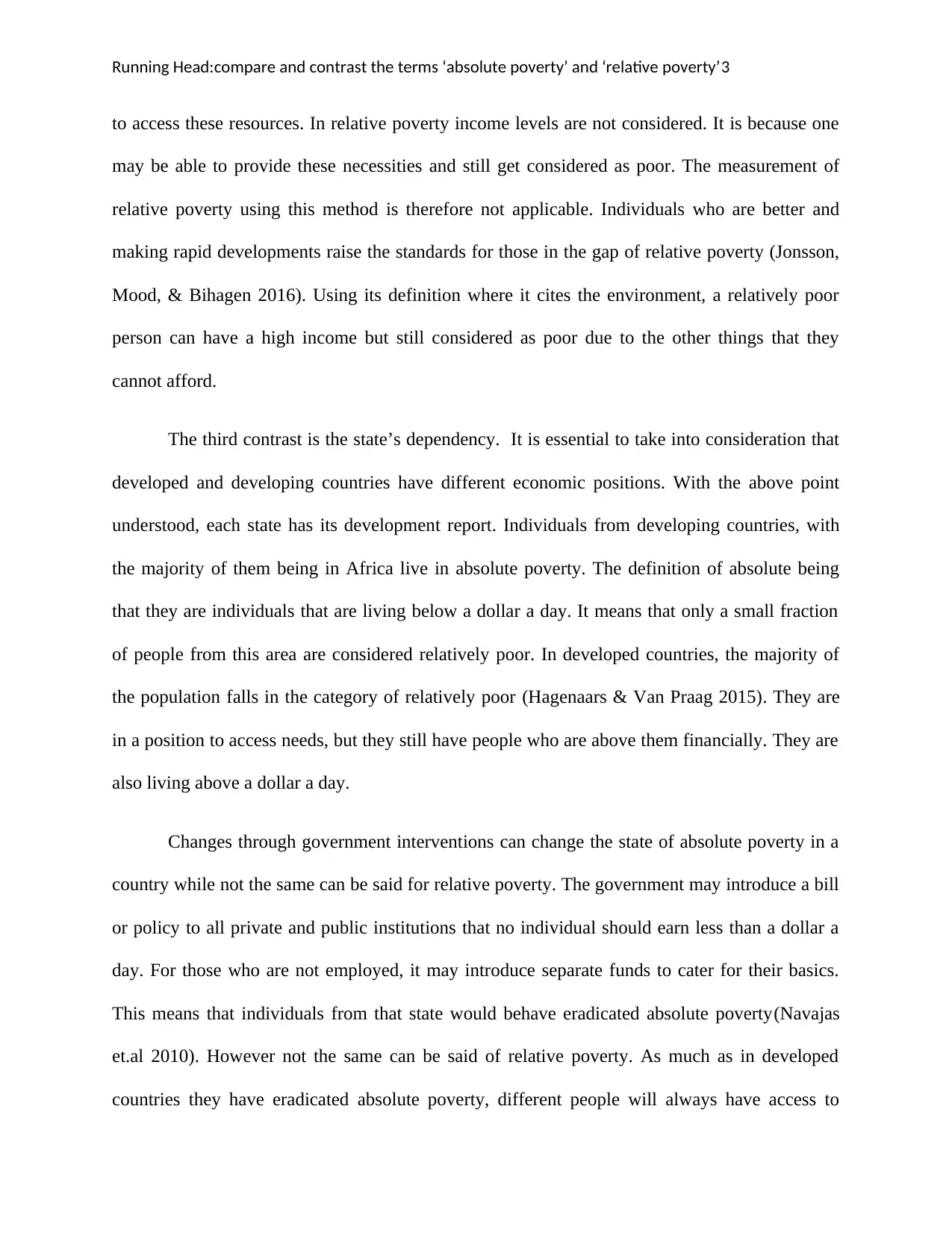
Running Head:compare and contrast the terms ‘absolute poverty’ and ‘relative poverty’3
to access these resources. In relative poverty income levels are not considered. It is because one
may be able to provide these necessities and still get considered as poor. The measurement of
relative poverty using this method is therefore not applicable. Individuals who are better and
making rapid developments raise the standards for those in the gap of relative poverty (Jonsson,
Mood, & Bihagen 2016). Using its definition where it cites the environment, a relatively poor
person can have a high income but still considered as poor due to the other things that they
cannot afford.
The third contrast is the state’s dependency. It is essential to take into consideration that
developed and developing countries have different economic positions. With the above point
understood, each state has its development report. Individuals from developing countries, with
the majority of them being in Africa live in absolute poverty. The definition of absolute being
that they are individuals that are living below a dollar a day. It means that only a small fraction
of people from this area are considered relatively poor. In developed countries, the majority of
the population falls in the category of relatively poor (Hagenaars & Van Praag 2015). They are
in a position to access needs, but they still have people who are above them financially. They are
also living above a dollar a day.
Changes through government interventions can change the state of absolute poverty in a
country while not the same can be said for relative poverty. The government may introduce a bill
or policy to all private and public institutions that no individual should earn less than a dollar a
day. For those who are not employed, it may introduce separate funds to cater for their basics.
This means that individuals from that state would behave eradicated absolute poverty(Navajas
et.al 2010). However not the same can be said of relative poverty. As much as in developed
countries they have eradicated absolute poverty, different people will always have access to
to access these resources. In relative poverty income levels are not considered. It is because one
may be able to provide these necessities and still get considered as poor. The measurement of
relative poverty using this method is therefore not applicable. Individuals who are better and
making rapid developments raise the standards for those in the gap of relative poverty (Jonsson,
Mood, & Bihagen 2016). Using its definition where it cites the environment, a relatively poor
person can have a high income but still considered as poor due to the other things that they
cannot afford.
The third contrast is the state’s dependency. It is essential to take into consideration that
developed and developing countries have different economic positions. With the above point
understood, each state has its development report. Individuals from developing countries, with
the majority of them being in Africa live in absolute poverty. The definition of absolute being
that they are individuals that are living below a dollar a day. It means that only a small fraction
of people from this area are considered relatively poor. In developed countries, the majority of
the population falls in the category of relatively poor (Hagenaars & Van Praag 2015). They are
in a position to access needs, but they still have people who are above them financially. They are
also living above a dollar a day.
Changes through government interventions can change the state of absolute poverty in a
country while not the same can be said for relative poverty. The government may introduce a bill
or policy to all private and public institutions that no individual should earn less than a dollar a
day. For those who are not employed, it may introduce separate funds to cater for their basics.
This means that individuals from that state would behave eradicated absolute poverty(Navajas
et.al 2010). However not the same can be said of relative poverty. As much as in developed
countries they have eradicated absolute poverty, different people will always have access to
⊘ This is a preview!⊘
Do you want full access?
Subscribe today to unlock all pages.

Trusted by 1+ million students worldwide
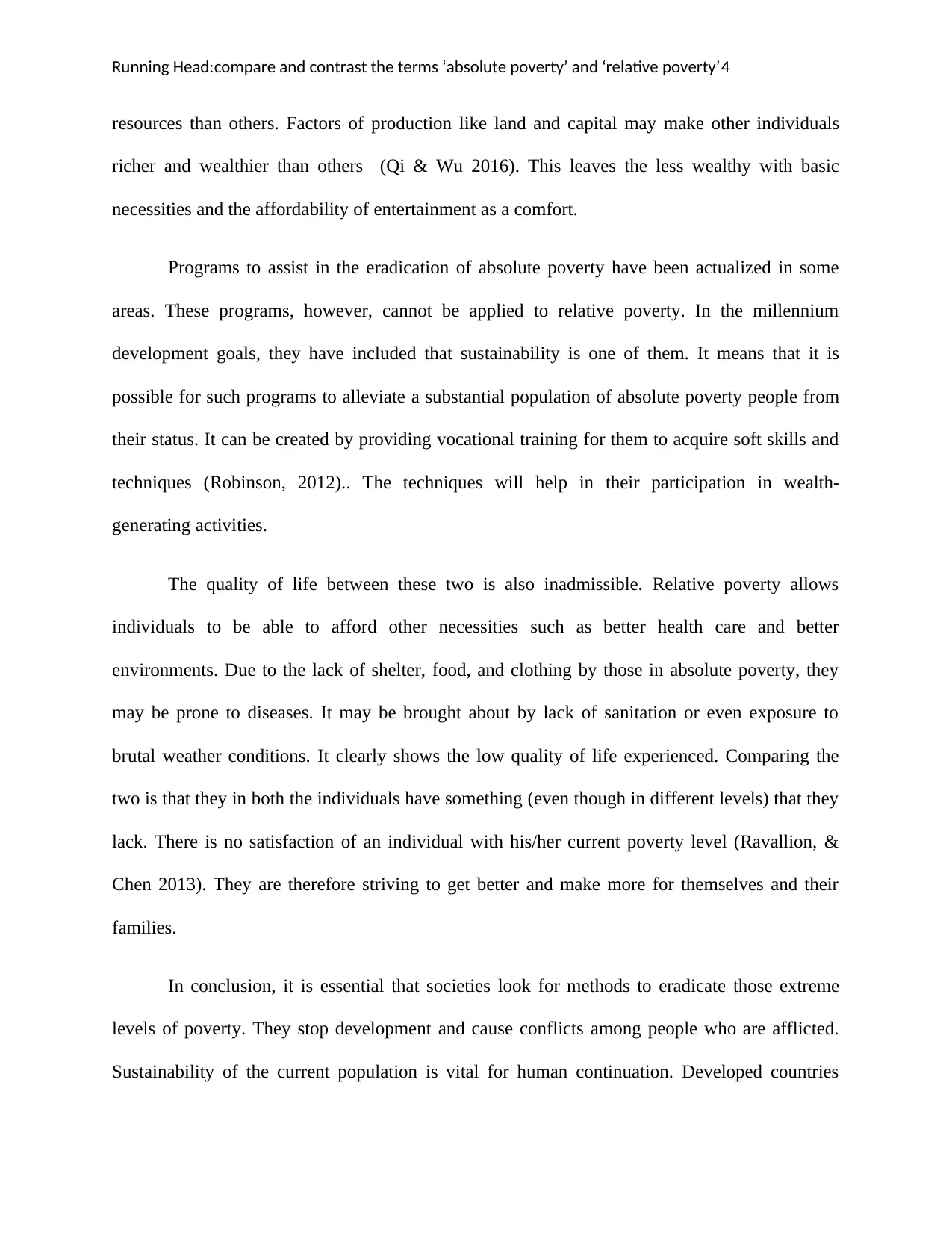
Running Head:compare and contrast the terms ‘absolute poverty’ and ‘relative poverty’4
resources than others. Factors of production like land and capital may make other individuals
richer and wealthier than others (Qi & Wu 2016). This leaves the less wealthy with basic
necessities and the affordability of entertainment as a comfort.
Programs to assist in the eradication of absolute poverty have been actualized in some
areas. These programs, however, cannot be applied to relative poverty. In the millennium
development goals, they have included that sustainability is one of them. It means that it is
possible for such programs to alleviate a substantial population of absolute poverty people from
their status. It can be created by providing vocational training for them to acquire soft skills and
techniques (Robinson, 2012).. The techniques will help in their participation in wealth-
generating activities.
The quality of life between these two is also inadmissible. Relative poverty allows
individuals to be able to afford other necessities such as better health care and better
environments. Due to the lack of shelter, food, and clothing by those in absolute poverty, they
may be prone to diseases. It may be brought about by lack of sanitation or even exposure to
brutal weather conditions. It clearly shows the low quality of life experienced. Comparing the
two is that they in both the individuals have something (even though in different levels) that they
lack. There is no satisfaction of an individual with his/her current poverty level (Ravallion, &
Chen 2013). They are therefore striving to get better and make more for themselves and their
families.
In conclusion, it is essential that societies look for methods to eradicate those extreme
levels of poverty. They stop development and cause conflicts among people who are afflicted.
Sustainability of the current population is vital for human continuation. Developed countries
resources than others. Factors of production like land and capital may make other individuals
richer and wealthier than others (Qi & Wu 2016). This leaves the less wealthy with basic
necessities and the affordability of entertainment as a comfort.
Programs to assist in the eradication of absolute poverty have been actualized in some
areas. These programs, however, cannot be applied to relative poverty. In the millennium
development goals, they have included that sustainability is one of them. It means that it is
possible for such programs to alleviate a substantial population of absolute poverty people from
their status. It can be created by providing vocational training for them to acquire soft skills and
techniques (Robinson, 2012).. The techniques will help in their participation in wealth-
generating activities.
The quality of life between these two is also inadmissible. Relative poverty allows
individuals to be able to afford other necessities such as better health care and better
environments. Due to the lack of shelter, food, and clothing by those in absolute poverty, they
may be prone to diseases. It may be brought about by lack of sanitation or even exposure to
brutal weather conditions. It clearly shows the low quality of life experienced. Comparing the
two is that they in both the individuals have something (even though in different levels) that they
lack. There is no satisfaction of an individual with his/her current poverty level (Ravallion, &
Chen 2013). They are therefore striving to get better and make more for themselves and their
families.
In conclusion, it is essential that societies look for methods to eradicate those extreme
levels of poverty. They stop development and cause conflicts among people who are afflicted.
Sustainability of the current population is vital for human continuation. Developed countries
Paraphrase This Document
Need a fresh take? Get an instant paraphrase of this document with our AI Paraphraser
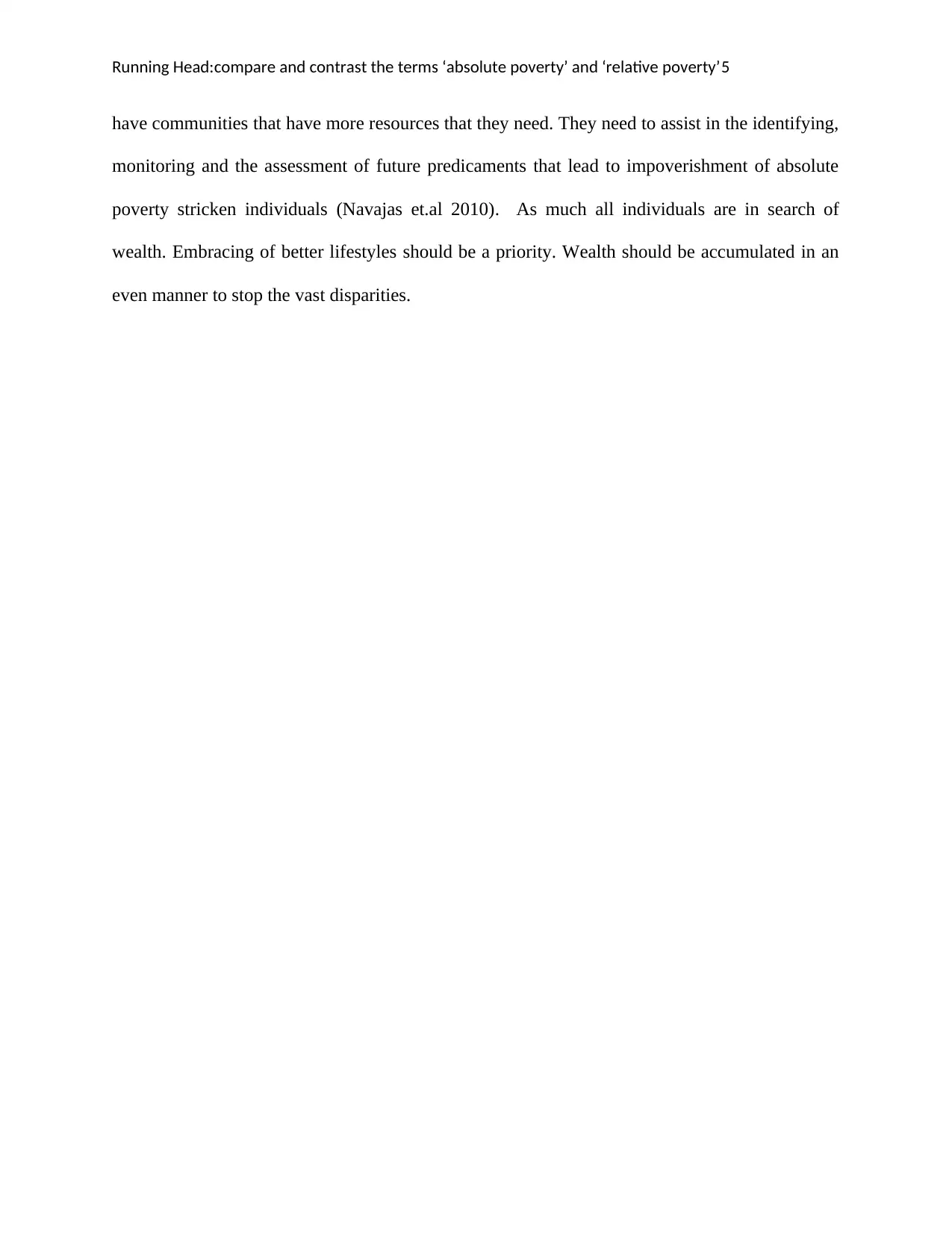
Running Head:compare and contrast the terms ‘absolute poverty’ and ‘relative poverty’5
have communities that have more resources that they need. They need to assist in the identifying,
monitoring and the assessment of future predicaments that lead to impoverishment of absolute
poverty stricken individuals (Navajas et.al 2010). As much all individuals are in search of
wealth. Embracing of better lifestyles should be a priority. Wealth should be accumulated in an
even manner to stop the vast disparities.
have communities that have more resources that they need. They need to assist in the identifying,
monitoring and the assessment of future predicaments that lead to impoverishment of absolute
poverty stricken individuals (Navajas et.al 2010). As much all individuals are in search of
wealth. Embracing of better lifestyles should be a priority. Wealth should be accumulated in an
even manner to stop the vast disparities.
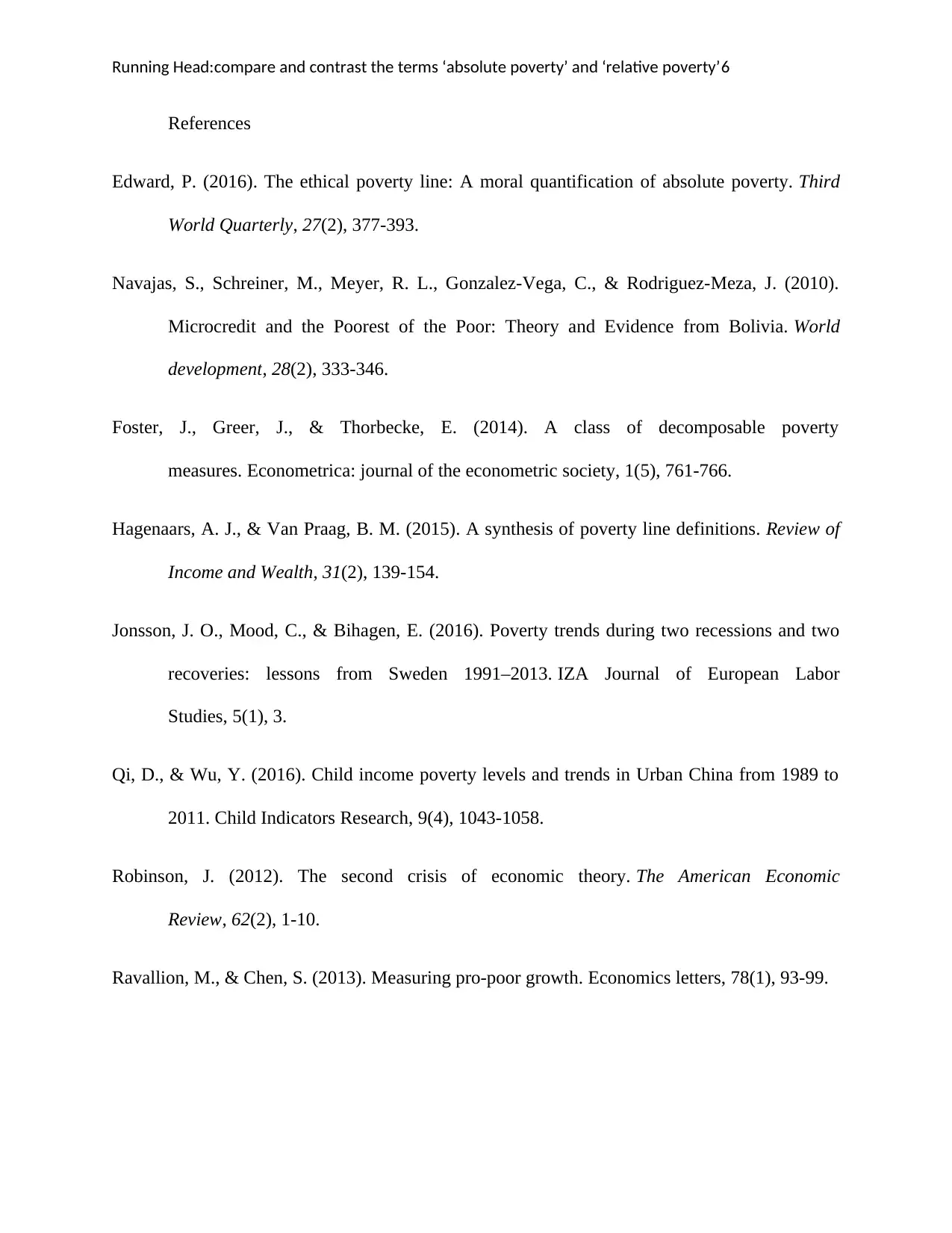
Running Head:compare and contrast the terms ‘absolute poverty’ and ‘relative poverty’6
References
Edward, P. (2016). The ethical poverty line: A moral quantification of absolute poverty. Third
World Quarterly, 27(2), 377-393.
Navajas, S., Schreiner, M., Meyer, R. L., Gonzalez-Vega, C., & Rodriguez-Meza, J. (2010).
Microcredit and the Poorest of the Poor: Theory and Evidence from Bolivia. World
development, 28(2), 333-346.
Foster, J., Greer, J., & Thorbecke, E. (2014). A class of decomposable poverty
measures. Econometrica: journal of the econometric society, 1(5), 761-766.
Hagenaars, A. J., & Van Praag, B. M. (2015). A synthesis of poverty line definitions. Review of
Income and Wealth, 31(2), 139-154.
Jonsson, J. O., Mood, C., & Bihagen, E. (2016). Poverty trends during two recessions and two
recoveries: lessons from Sweden 1991–2013. IZA Journal of European Labor
Studies, 5(1), 3.
Qi, D., & Wu, Y. (2016). Child income poverty levels and trends in Urban China from 1989 to
2011. Child Indicators Research, 9(4), 1043-1058.
Robinson, J. (2012). The second crisis of economic theory. The American Economic
Review, 62(2), 1-10.
Ravallion, M., & Chen, S. (2013). Measuring pro-poor growth. Economics letters, 78(1), 93-99.
References
Edward, P. (2016). The ethical poverty line: A moral quantification of absolute poverty. Third
World Quarterly, 27(2), 377-393.
Navajas, S., Schreiner, M., Meyer, R. L., Gonzalez-Vega, C., & Rodriguez-Meza, J. (2010).
Microcredit and the Poorest of the Poor: Theory and Evidence from Bolivia. World
development, 28(2), 333-346.
Foster, J., Greer, J., & Thorbecke, E. (2014). A class of decomposable poverty
measures. Econometrica: journal of the econometric society, 1(5), 761-766.
Hagenaars, A. J., & Van Praag, B. M. (2015). A synthesis of poverty line definitions. Review of
Income and Wealth, 31(2), 139-154.
Jonsson, J. O., Mood, C., & Bihagen, E. (2016). Poverty trends during two recessions and two
recoveries: lessons from Sweden 1991–2013. IZA Journal of European Labor
Studies, 5(1), 3.
Qi, D., & Wu, Y. (2016). Child income poverty levels and trends in Urban China from 1989 to
2011. Child Indicators Research, 9(4), 1043-1058.
Robinson, J. (2012). The second crisis of economic theory. The American Economic
Review, 62(2), 1-10.
Ravallion, M., & Chen, S. (2013). Measuring pro-poor growth. Economics letters, 78(1), 93-99.
⊘ This is a preview!⊘
Do you want full access?
Subscribe today to unlock all pages.

Trusted by 1+ million students worldwide
1 out of 6
Related Documents
Your All-in-One AI-Powered Toolkit for Academic Success.
+13062052269
info@desklib.com
Available 24*7 on WhatsApp / Email
![[object Object]](/_next/static/media/star-bottom.7253800d.svg)
Unlock your academic potential
Copyright © 2020–2025 A2Z Services. All Rights Reserved. Developed and managed by ZUCOL.





